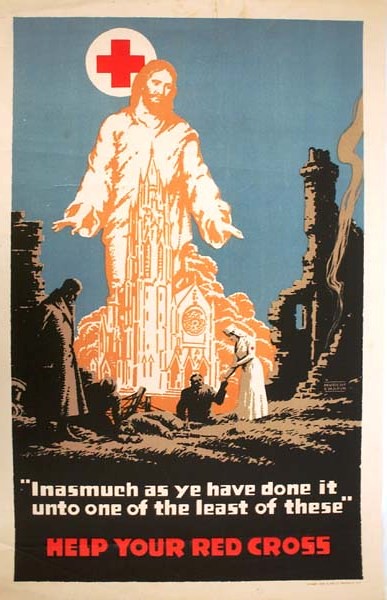
https://www.flickr.com/photos/mfspeccoll/4902821439/in/album-72157624742...
Like most Red Cross images, this advertisement also has a religious underpinning. It is more than the nature of the organization it is trying to represent that causes the Red Cross images to appear less “war like”. The main idea of the image seems to be that the advertisers want people to think on saving lives rather than spending them in war. The images are not anti-war, but the message is very different in their call to action.
Advertisers want people to equate the Red Cross with the crucifix, Jesus, religion, mercy, and hope. These are very different call to actions than other war posters that are meant to inspire men to fight, families to risk money, or families to go without food stuffs. This poster seems to suggest that the Red Cross is a manifestation of Jesus Christ and that the men, specifically strangers, should be treated as family or else your family member will be treated less by God. The larger than human size Jesus within the art who is situated behind the active people in the foreground is meant to remind people of the power of God. The Red Cross at the level of his head and slightly behind his head symbolizing that the Red Cross is behind and equal to Jesus.
The Red Cross symbology in the poster is disconnected to the real workings of nursing during WWI. Vera Brittain might laugh at the placid foreground scene considering how gruesome the real work of war nursing was. The poster scene is an entire disconnect from reality. Yet, the effects of the imagery of the war nurse in her uniform had to have played a part in Brittain’s life. She would have been looked at differently when in her uniform. Certain social actions would have been expected of her while in uniform. Her descriptions in her memoir give a sense to the reader that Brittain in uniform was different from the Brittain out of uniform. I do not think that the effects of this prestige was lost on her entirely because she uses her position to speak about the war with an authority over other homefront women. The irony is that the poster’s overglorified imagery is disconnected from reality yet a real life war nurse uses the iconography to her advantage.
“Inasmuch as Ye Have Done It Unto One of the Least of These...” Flickr, Latham Litho. and Ptg Co., Brooklyn, New York, 1910, www.utulsa.edu/liraries/mcfarlin/special-collections.aspx.
